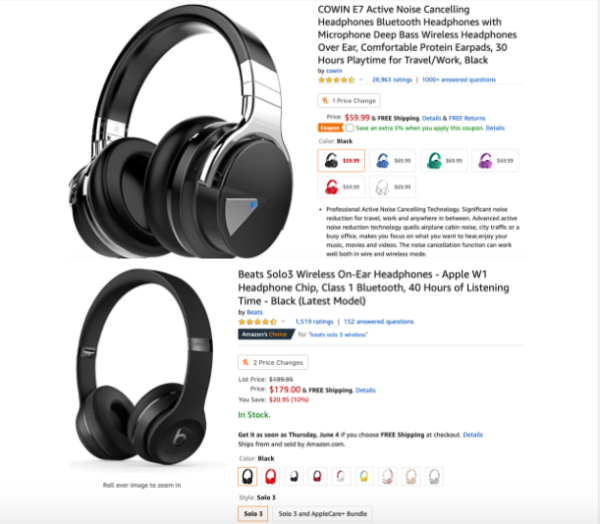Want to hear a little secret in the marketing world? Marketers need to promote themselves as well to attract clients, resources, and respect, which has led to popular terms like brand marketing and content marketing. While these fields are important — and have been marketed effectively — marketers and brand leaders should stay open to any strategy that delivers the best results.
In many cases, that means turning to feature marketing to help your products and services stand out, even when competing against big brands.
As the name implies, feature marketing involves highlighting specific features of your offerings, such as if a watchmaker doubles down on atomic accuracy rather than creating a luxurious association with the brand.
Compared with brand marketing or content marketing, feature marketing tends to be less sexy and more technical. Think of how Dollar Shave Club built momentum around building a fun brand identity, with its tongue-in-cheek online commercials, while only lightly touting specific features.
While this brand marketing strategy works for some, not everyone has the right combination of time, money, talent, charm, and luck needed to build a brand. However, many brands could improve sales by focusing on feature marketing, which can lead to stronger brand growth over time.
A Feature-Centric Approach for Headphones
By focusing on feature marketing, small brands can swoop in to attract customers, without having to put significant spend into their efforts.
For example, when you think of wireless headphones, you probably think of brands like Bose or Apple (for AirPods and because Apple owns Beats by Dr. Dre). While the brand-building from these companies has undoubtedly led to tremendous sales, if you search Amazon for “wireless headphones,” the first three non-sponsored results are from Letscom, iJoy, and Cowin. Even though these aren’t exactly household brands, their focus on specific features helps them rank high, which can lead to sales that might have otherwise gone to better-known brands.
If you look at the descriptions for these products, you’ll see that some of these smaller brands have excelled at SEO by focusing on features that consumers would naturally search for. For example, the phrase “wireless headphones” does not appear anywhere in Apple’s Amazon listing description for AirPods, nor does it appear on a Beats by Dr. Dre Powerbeats3 listing, which competes at a price point closer to some of these smaller brands.
The reasoning behind these descriptions could very well come down to product styles, in that Powerbeats3 and AirPods could technically be considered earphones, whereas a high-ranked listing for Cowin over-ear headphones uses the term “wireless headphones” in its Amazon product title. Yet Apple uses the term “headphones” in association with AirPods on its own website. Plus, Beats sells over-ear wireless headphones that do not show up in these top Amazon rankings, likely because they use terms like “wireless on-ear headphones,” which breaks up the “wireless headphones” keyphrase.
Screenshots of Cowin vs. Beats wireless headphone listings: Consider the relatively similar styles, compared with the discrepancies in feature marketing and the number of reviews.
While no one would say Cowin is about to overtake Apple, Cowin is seizing an opportunity to get organic visibility from customers who are searching for wireless headphones. This visibility makes a difference considering the top-three search results on Amazon account for 64% of clicks, and 70% of Amazon searchers only view the first page of results, as Search Engine Journal reports, based on Amazon’s own data.
Moreover, Cowin excels at feature marketing by highlighting other top attributes that customers care about when searching for headphones, beyond brand recognition.
For example, an analysis by Revuze of customer feedback data finds that in the wireless headphones market, “comfortable” is a top-five topic in terms of consumer importance/volume. Sure enough, Cowin uses the term “comfortable” in the product title and uses a variation of that term four other times in the product description. In contrast, the “wireless on-ear headphones” from Beats only mentions “comfort” once, and not in the product title.
Leverage Customer Feedback
As these examples show, highlighting specific features that customers care about can be a targeted way to get in front of your intended audience.
To find out what those terms should be, you need to listen to customer feedback. By looking at sources such as reviews and social media discussions of both your own products/services and those of competitors, you can conduct sentiment analysis and then make data-driven decisions about what customers care about.
However, you do not want to get too general. The more you can personalize your sentiment analysis and understand what features to market to different types of customers, even if that means directly responding to a negative review with a better solution, then the more effective your feature marketing will likely be.
Use Feature Marketing as a Guide
If you can’t market features that customers are searching for because you don’t offer them, then that could be a sign you need to either work on moving the conversation in a new direction or need to create offerings that feed consumer demand. Otherwise, you could end up wasting resources marketing features that consumers do not seem to want.
Ultimately, by honing in on features that customers want, you not only can increase search visibility that can lead to sales (depending on the strength of your offer once customers click through), but you can also create a positive feedback loop.
Consider how Cowin’s highly ranked wireless headphones listing has nearly 30,000 reviews, roughly twice as much as Apple has for its AirPods Pro. Not only does that indicate Cowin has found a sizable market, but they can also leverage this high volume of feedback to learn more about which features customers like and which need improvement.
That’s the power of feature marketing. Brand marketing and content marketing still have their place, but if you want a more targeted approach that can help you quickly take on larger competitors, feature marketing could be the way forward.
